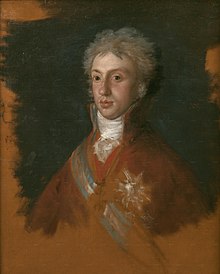

| Louis I | |||||
|---|---|---|---|---|---|

Portrait by Goya, 1800
| |||||
| King of Etruria | |||||
| Reign | 21 March 1801 – 27 May 1803 | ||||
| Predecessor | Ferdinand III as Grand Duke of Tuscany | ||||
| Successor | Louis II | ||||
| |||||
| Born | (1773-07-05)5 July 1773 Piacenza, Duchy of Parma | ||||
| Died | 27 May 1803(1803-05-27) (aged 29) Florence, Kingdom of Etruria | ||||
| Burial | |||||
| Consort | Maria Luisa of Spain | ||||
| Issue | Charles II, Duke of Parma Maria Luisa Carlota, Hereditary Princess of Saxony | ||||
| |||||
| House | Bourbon-Parma | ||||
| Father | Ferdinand, Duke of Parma | ||||
| Mother | Maria Amalia of Austria | ||||
| Religion | Roman Catholicism | ||||
Louis I (Italian: Ludovico I; 5 July 1773 – 27 May 1803) was the first of the two kings of Etruria. Louis was the son of Ferdinand, Duke of Parma, and Maria Amalia of Austria. He was born in 1773, when his great-grandfather, King Louis XV of France, was still alive.
Louis Francis Philibert (Italian: Ludovico Francesco Filiberto) was the second child and eldest son of Ferdinand, Duke of Parma, a grandson of French King Louis XV and Marie Leczinska, and his wife Archduchess Maria Amalia of Austria. Louis and his older sister Carolina were the favorites of their parents. They were personally instructed in religion by their father, despite the fact that their younger children was actually more interested in the subject than they were.[1] In 1778, he hit his head on a marble table while playing with Carolina, and afterward suffered from epilepsy.[1]
In 1795, Louis came to the Spanish court to finish his education and also to marry one of the daughters of King Charles IV of Spain, who were his first cousins. He was to marry Infanta Maria Amalia or Infanta Maria Luisa, and chose the latter, who was somewhat more attractive and cheerful than the melancholy Maria Amalia. On 25 August 1795, he married Maria Luisa at Madrid and was made an InfanteofSpain.
The marriage between the two different personalities turned out to be happy, though it was clouded by Louis's ill health. He was frail, suffered chest problems, and since a childhood accident when he hit his head on a marble table, suffered from symptoms that have been identified as epileptic fits. As the years went on, his health deteriorated, and he grew to be increasingly dependent on his wife. The young couple remained in Spain during the early years of their marriage.
The couple had two children:

While Louis was staying in Spain, the Duchy of Parma had been occupied by French troops in 1796. Napoleon Bonaparte, who had conquered most of Italy and wanted to gain Spain as an ally against England, proposed to compensate the House of Bourbon for their loss of the Duchy of Parma with the Kingdom of Etruria, a new state that he created from the Grand Duchy of Tuscany. This was agreed upon in the Treaty of Aranjuez.
Louis had to receive his investiture from Napoleon in Paris, before taking possession of Etruria. Louis, his wife and his son travelled incognito through France under the name of the Count of Livorno. Having been invested in Paris as King of Etruria, Louis and his family arrived in August 1801 at his new capital, Florence.
In 1802, both Louis and his pregnant wife travelled to Spain to attend the double-wedding of Maria Luisa's brother Ferdinand and her youngest sister Maria Isabel. Offshore at Barcelona, Maria Luisa gave birth to their daughter, Marie Louise Charlotte. The couple returned in December of that year, after having been notified of the death of Louis's father.
Back in Etruria, Louis's health worsened, and in May 1803, he died at the age of twenty-nine, possibly due to an epileptic crisis. He was succeeded by his son, Charles Louis, as King Louis II of Etruria, under the regency of his mother, Maria Luisa.

| Ancestors of Louis I of Etruria |
|---|
Louis I of Etruria Cadet branch of the Capetian dynasty Born: 5 July 1773 Died: 27 May 1803 | ||
| Regnal titles | ||
|---|---|---|
| Preceded by
Ferdinand III |
King of Etruria 1801–1803 |
Succeeded by |
|
Princes of Parma
| |
|---|---|
| 1st generation |
|
| 2nd generation |
|
| 3rd generation |
|
| 4th generation |
|
| 5th generation |
|
| 6th generation |
|
| 7th generation |
|
| 8th generation |
|
| 9th generation |
|
| 10th generation |
|
| 11th generation |
|
| 12th generation |
|
| 13th generation |
|
| 14th generation |
|
| 15th generation |
|
| 16th generation |
|
| |
|
| |
|---|---|
The generations indicate descent from Carlos I, under whom the crowns of Castile and Aragon were united, forming the Kingdom of Spain. Previously, the title Infante had been largely used in the different realms. | |
| 1st generation |
|
| 2nd generation |
|
| 3rd generation |
|
| 4th generation |
|
| 5th generation |
|
| 6th generation |
|
| 7th generation |
|
| 8th generation |
|
| 9th generation |
|
| 10th generation |
|
| 11th generation |
|
| 12th generation |
|
| 13th generation |
|
| 14th generation |
|
| 15th generation |
|
| 16th generation |
|
| |
| International |
|
|---|---|
| National |
|
| Artists |
|
| People |
|
| Other |
|